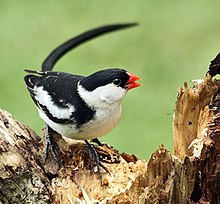Date: May 11, 2017
Source: The City University of
New York
 Invasive parasites are a
biological oxymoron. And yet, they are in our backyards! This study analyzes
the case of a brood parasitic bird, the pin-tailed whydah (Vidua macroura) and its recent spread into the Americas!
Invasive parasites are a
biological oxymoron. And yet, they are in our backyards! This study analyzes
the case of a brood parasitic bird, the pin-tailed whydah (Vidua macroura) and its recent spread into the Americas!
Biodiversity hotspots -- or
places with large numbers of species found nowhere else on earth -- also tend
to make suitable habitats for invasive species that can, in turn, destabilize
ecosystems and supplant indigenous biota. A new study in The Condor:
Ornithological Applications predicts where the pin-tailed whydah, a songbird
native to sub-Saharan Africa that has expanded its natural range thanks to the
pet trade, may next spread in North America and Hawaii.
The pin-tailed whydah is a brood
parasitic bird that lays its eggs in other bird species, typically small
African finches, and has been introduced from Africa to Puerto Rico and
southern California. In this study, researchers used species distribution
models to predict where the whydah may continue to spread in the continental
U.S., Hawaii, and the Antilles. To determine the whydah's potential
distribution, they used sightings of this species reported to the Global
Biodiversity Information Facility (GBIF). The investigators then identified
suitable whydah habitat by finding correlations between locations where these
finches have been seen and global climate data. As brood parasites, whydahs
need hosts to complete their life cycle, so the researchers also used the
presence of six known host species that have been co-introduced in the whydah's
new range to predict suitable habitat. Their species distribution model
indicated high habitat suitability in areas of high biodiversity where whydahs
do not currently live, including the West Coast of the U.S., Hawaii, and most
islands of the Antilles.
No comments:
Post a Comment